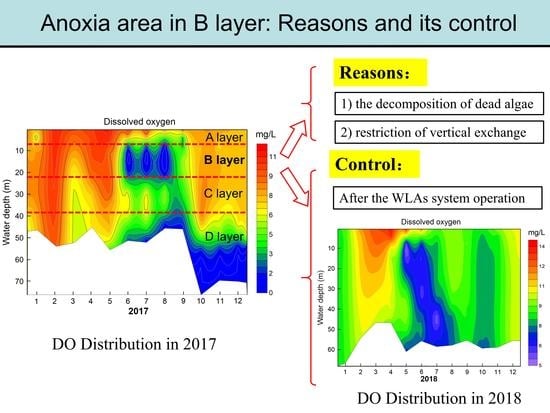S-type Dissolved Oxygen Distribution along Water Depth in a Canyon-shaped and Algae Blooming Water Source Reservoir: Reasons and Control
Abstract
1. Introduction
2. Materials and Methods
2.1. Study Site
2.2. Introduction of Water-Lifting Aerators in Lijiahe Reservoir
2.3. Sampling and Analysis
2.4. Calculation Method of the RWCS/H Index
2.5. Data Analysis
3. Results and Discussion
3.1. DO Distribution along Water Depth over One Year
3.2. Reasons for the Formation of Anoxic Area in B Layer
3.2.1. Thermal Stratification on the Formation of S-type DO Distribution
3.2.2. The Contribution of Algae Blooming to the Anoxia Area in B Layer
3.2.3. The Influence of Interflow on the Anoxic Area in B Layer
3.2.4. Side Wall Effect
3.3. Improvement of the Anoxic Area by Water Lifting Aerator
4. Conclusions
Supplementary Materials
Author Contributions
Acknowledgments
Conflicts of Interest
References
- He, G.J.; Fang, H.W.; Bai, S.; Liu, X.B.; Chen, M.G.; Bai, J. Application of a three-dimensional eutrophication model for the Beijing Guanting Reservoir, China. Ecol. Model. 2011, 222, 1491–1501. [Google Scholar] [CrossRef]
- Wang, S.; Qian, X.; Han, B.P.; Luo, L.C.; Hamilton, D.P. Effects of local climate and hydrological conditions on the thermal regime of a reservoir at Tropic of Cancer, in southern China. Water Res. 2012, 46, 2591–2604. [Google Scholar] [CrossRef]
- Jones, I.D.; Winfield, I.J.; Carse, F. Assessment of long-term changes in habitat availability for Arctic charr (Salvelinus alpinus) in a temperate lake using oxygen profiles and hydroacoustic surveys. Freshw. Biol. 2010, 53, 393–402. [Google Scholar] [CrossRef]
- Elçi, Ş. Effects of thermal stratification and mixing on reservoir water quality. Limnology 2008, 9, 135–142. [Google Scholar] [CrossRef]
- Fan, C.W.; Kao, S.J. Effects of climate events driven hydrodynamics on dissolved oxygen in a subtropical deep reservoir in Taiwan. Sci. Total Environ. 2008, 393, 326–332. [Google Scholar] [CrossRef]
- Gantzer, P.A.; Bryant, L.D.; Little, J.C. Effect of hypolimnetic oxygenation on oxygen depletion rates in two water-supply reservoirs. Water Res. 2009, 43, 1700–1710. [Google Scholar] [CrossRef]
- Arend, K.K.; Beletsky, D.; Depinto, J.V.; Ludsin, S.A.; Roberts, J.J.; Rucinski, D.K.; Scavia, D.; Schwab, D.J.; Höök, T.O. Seasonal and interannual effects of hypoxia on fish habitat quality in central Lake Erie. Freshw. Biol. 2011, 56, 366–383. [Google Scholar] [CrossRef]
- Hupfer, M.; Lewandowski, J. Oxygen Controls the Phosphorus Release from Lake Sediments—A Long-Lasting Paradigm in Limnology. Int. Rev. Hydrobiol. 2010, 93, 415–432. [Google Scholar] [CrossRef]
- Zhang, Y.L.; Wu, Z.X.; Liu, M.L.; He, J.B.; Shi, K.; Zhou, Y.Q.; Wang, M.Z.; Liu, X.H. Dissolved oxygen stratification and response to thermal structure and long-term climate change in a large and deep subtropical reservoir (Lake Qiandaohu, China). Water Res. 2015, 75, 249–258. [Google Scholar] [CrossRef]
- Effler, S.; Gelda, R.; Perkins, M.; Matthews, D.; Owens, E.; Stepczuk, C.; Bader, A. Characteristics and Origins of Metalimnetic Dissolved Oxygen Minima in a Eutrophic Reservoir. Lake Reserv. Manag. 1998, 14, 332–343. [Google Scholar] [CrossRef]
- Beutel, M.W.; Leonard, T.M.; Dent, S.R.; Moore, B.C. Effects of aerobic and anaerobic conditions on P, N, Fe, Mn, and Hg accumulation in waters overlaying profundal sediments of an oligo-mesotrophic lake. Water Res. 2008, 42, 1953–1962. [Google Scholar] [CrossRef]
- Jankowski, T.; Livingstone, D.M.; Bührer, H.; Niederhauser, F.P. Consequences of the 2003 European Heat Wave for Lake Temperature Profiles, Thermal Stability, and Hypolimnetic Oxygen Depletion: Implications for a Warmer World. Limnol. Oceanogr. 2006, 51, 815–819. [Google Scholar] [CrossRef]
- Yang, X.; Huang, T.L.; Zhang, H.H. Effects of Seasonal Thermal Stratification on the Functional Diversity and Composition of the Microbial Community in a Drinking Water Reservoir. Water 2015, 7, 5525–5546. [Google Scholar] [CrossRef]
- Wetzel, R.G. Limnology: Lake and River Ecosystems, 3rd ed.; Elsevier: San Diego, CA, USA, 2001; pp. 368–369. [Google Scholar]
- Wentzky, V.; Frassl, M.; Rinke, K.; Boehrer, B. Metalimnetic oxygen minimum and the presence of Planktothrix rubescens in a low-nutrient drinking water reservoir. Water Res. 2018, 148, 208–218. [Google Scholar] [CrossRef]
- Kreling, J.; Bravidor, J.; Engelhardt, C.; Hupfer, M.; Koschorreck, M.; Lorke, A. The importance of physical transport and oxygen consumption for the development of a metalimnetic oxygen minimum in a lake. Limnol. Oceanogr. 2017, 62, 348–363. [Google Scholar] [CrossRef]
- Nix, J. Contribution of hypolimnetic water on metalimnetic dissolved oxygen minima in a reservoir. Water Resour. Res. 1981, 17, 329–332. [Google Scholar] [CrossRef]
- Sun, X.; Li, X.; Zhang, M.D.; Huang, T.L.; Liu, W. Comparison of water-lifting aerator type for algae inhibition in stratified source water reservoirs. Ecol. Eng. 2014, 73, 624–634. [Google Scholar] [CrossRef]
- Sharples, J.; Moore, C.M.; Rippeth, T.P. Phytoplankton distribution and survival in the thermocline. Limnol. Oceanogr. 2001, 46, 486–496. [Google Scholar] [CrossRef]
- Joehnk, K.D.; Umlauf, L. Modelling the metalimnetic oxygen minimum in a medium sized alpine lake. Ecol. Model. 2001, 136, 67–80. [Google Scholar] [CrossRef]
- Mcclure, R.P.; Hamre, K.D.; Niederlehner, B.R.; Munger, Z.W.; Chen, S.; Lofton, M.E.; Schreiber, M.E.; Carey, C.C. Metalimnetic oxygen minima alter the vertical profiles of carbon dioxide and methane in a managed freshwater reservoir. Sci. Total Environ. 2018, 636, 610–620. [Google Scholar] [CrossRef]
- Raateoja, M.; Kuosa, H.; Flinkman, J.; Pääkkönen, J.P.; Perttilä, M. Late summer metalimnetic oxygen minimum zone in the northern Baltic Sea. J. Mar. Syst. 2010, 80, 1–7. [Google Scholar] [CrossRef]
- Thompson, J.S.; Sykes, J.A. The Role of Metalimnetic Hypoxia in Striped Bass Summer Kills: Consequences and Management Implications. Am. Fish. Soc. Symp. 2013, 80, 121–145. [Google Scholar]
- Ma, W.X.; Huang, T.L.; Li, X. Study of the application of the water-lifting aerators to improve the water quality of a stratified, eutrophicated reservoir. Ecol. Eng. 2015, 83, 281–290. [Google Scholar] [CrossRef]
- Huang, T.L.; Ma, Y.; Cong, H.B.; Pan, T. Application of the technology of water lifting and aeration on improving water quality in a Deep Canyon Reservoir—A case study from northern China. Desalin. Water Treat. 2014, 52, 1636–1646. [Google Scholar] [CrossRef]
- Li, Y.; Huang, T.L.; Ma, W.X. Correlation Analysis of Rainstorm Runoff and Density Current in a Canyon-Shaped Source Water Reservoir: Implications for Reservoir Optimal Operation. Water 2018, 10, 447. [Google Scholar] [CrossRef]
- Li, Y.; Huang, T.L.; Tan, X.L.; Zhou, Z.Z.; Ma, W.X. Destratification and oxygenation efficiency of a water-lifting aerator system in a deep reservoir: Implications for optimal operation. J. Environ. Sci. 2018, 73, 9–19. [Google Scholar] [CrossRef]
- Ma, W.X.; Huang, T.L.; Li, X.; Zhou, Z.Z.; Li, Y.; Zeng, K. The Effects of Storm Runoff on Water Quality and the Coping Strategy of a Deep Canyon-Shaped Source Water Reservoir in China. Int. J. Environ. Res. Public Health 2015, 12, 7839–7855. [Google Scholar] [CrossRef]
- Rand, M.C.; Greenberg, A.E.; Taras, M.J. Standard Methods for the Examination of Water and Wastewater, 14th ed.; Freshwater Science: Washington, DC, USA, 1991. [Google Scholar]
- Blokda, W.; Khalil, K.; Loudiki, M.; Aziz, F.; Elkalay, K. First Assessment of Phytoplankton Diversity in a Marrocan Shallow Reservoir (Sidi Abderrahmane). 2017. Available online: https://doi.org/10.1016/j.sjbs.2017.11.047 (accessed on 26 November 2017).
- Çelekli, A.; Kapı, E.; Soysal, C.; Arslanargun, H.; Bozkurt, H. Evaluating biochemical response of filamentous algae integrated with different water bodies. Ecotoxicol. Environ. Saf. 2017, 142, 171–180. [Google Scholar] [CrossRef]
- Becker, V.; Huszar, V.L.M.; Naselli-Flores, L.; Padisák, J. Phytoplankton equilibrium phases during thermal stratification in a deep subtropical reservoir. Freshw. Biol. 2010, 53, 952–963. [Google Scholar] [CrossRef]
- Xiao, L.J.; Wang, T.; Hu, R.; Han, B.P.; Wang, S.; Qian, X.; Padisa´k, J. Succession of phytoplankton functional groups regulated by monsoonal hydrology in a large canyon-shaped reservoir. Water Res. 2011, 45, 5099–5109. [Google Scholar] [CrossRef]
- Li, X.; Huang, T.L.; Ma, W.X.; Sun, X.; Zhang, H.H. Effects of rainfall patterns on water quality in a stratified reservoir subject to eutrophication: Implications for management. Sci. Total Environ. 2015, 521–522, 27–36. [Google Scholar] [CrossRef]
- Wang, N.; Xiong, J.Q.; Wang, X.C.; Zhang, Y.; Liu, H.L.; Zhou, B.; Pan, P.; Liu, Y.Z.; Ding, F.Y. Relationship between phytoplankton community and environmental factors in landscape water with high salinity in a coastal city of China. Environ. Sci. Pollut. Res. 2018, 25, 28460–28470. [Google Scholar] [CrossRef]
- Huang, T.L.; Li, X.; Rijnaarts, H.; Grotenhuis, T.; Ma, W.X.; Sun, X.; Xu, J.L. Effects of storm runoff on the thermal regime and water quality of a deep, stratified reservoir in a temperate monsoon zone, in Northwest China. Sci. Total Environ. 2014, 485–486, 820–827. [Google Scholar] [CrossRef]
- Mao, W.X.; Huang, T.L.; Li, X.; Zhang, H.H.; Ju, T. Impact of short-term climate variation and hydrology change on thermal structure and water quality of a canyon-shaped, stratified reservoir. Environ. Sci. Pollut. Res. 2015, 22, 18372–18380. [Google Scholar] [CrossRef]
- Zhou, Z.Z.; Huang, T.L.; Li, Y.; Ma, W.X.; Zhou, S.L.; Long, S.H. Sediment pollution characteristics and in situ control in a deep drinking water reservoir. J. Environ. Sci. 2017, 52, 223–231. [Google Scholar] [CrossRef]
- Horppila, J.; Malinen, T.; Nurminen, L.; Tallberg, P.; Vinni, M. A metalimnetic oxygen minimum indirectly contributing to the low biomass of cladocerans in Lake Hiidenvesi—A diurnal study on the refuge effect. Hydrobiologia 2000, 436, 81–90. [Google Scholar] [CrossRef]
- Qiu, X.P.; Huang, T.L.; Zeng, M.Z. Differences in phytoplankton dynamics and community structure between a wet year and dry year in the Zhoucun Reservoir. J. Freshw. Ecol. 2016, 31, 377–391. [Google Scholar] [CrossRef]
- Shapiro, J. The Cause of a Metalimnetic Minimum of Dissolved Oxygen. Limnol. Oceanogr. 1960, 5, 216–227. [Google Scholar] [CrossRef]
- Shi, J.C.; Huang, T.L.; Wen, G.; Liu, F.; Qiu, X.P.; Wang, B.S. The Variation Characteristic of Sulfides and VOSc in a Source Water Reservoir and Its Control Using a Water-Lifting Aerator. Int. J. Environ. Res. Public Health 2016, 13, 427. [Google Scholar] [CrossRef]
- Li, Y.; Huang, T.L.; Zhou, Z.Z.; Long, S.H.; Zhang, H.H. Effects of reservoir operation and climate change on thermal stratification of a canyon-shaped reservoir, in northwest China. Water Sci. Technol. Water Supply 2018, 18, 418–429. [Google Scholar] [CrossRef]
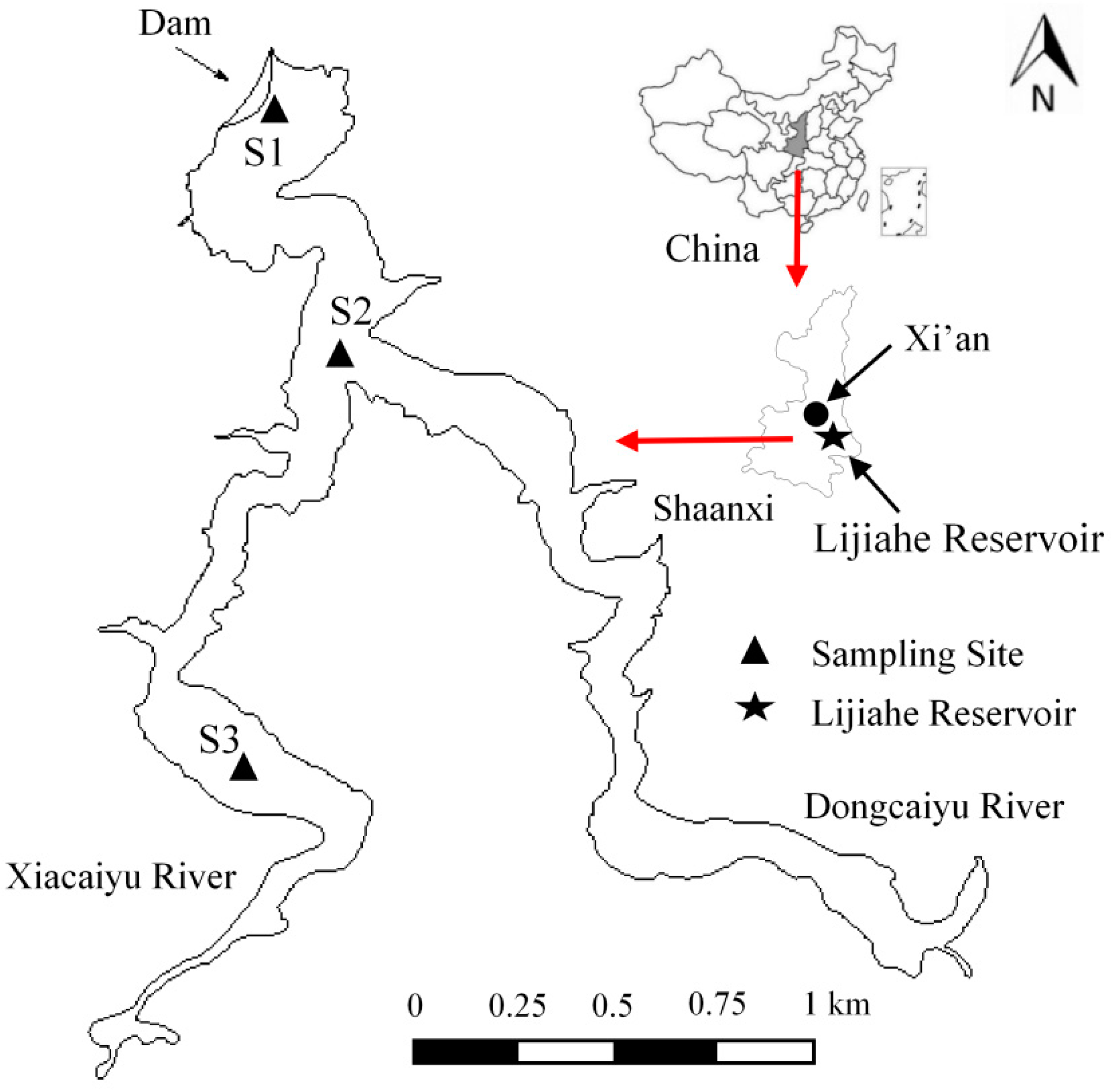
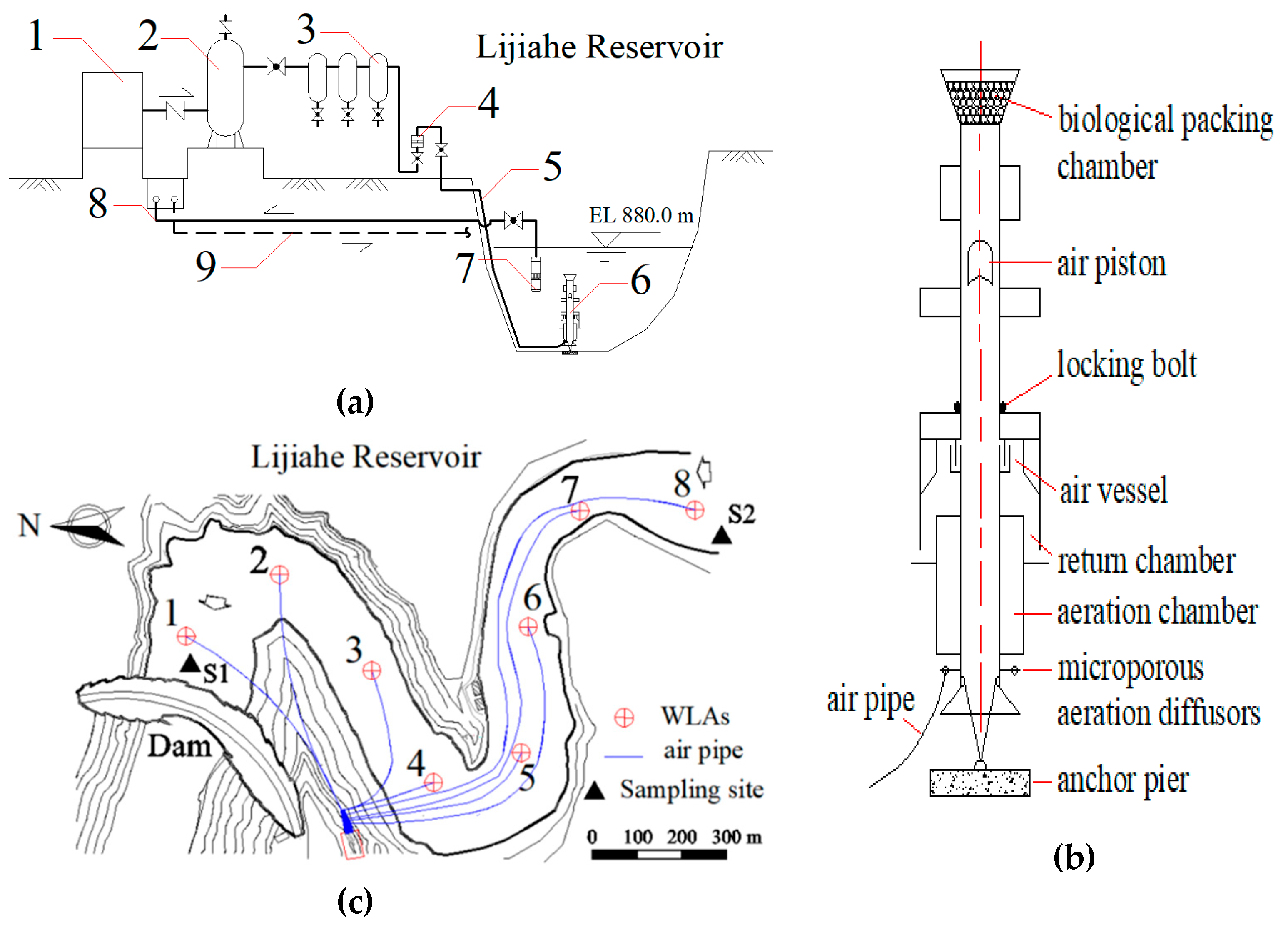
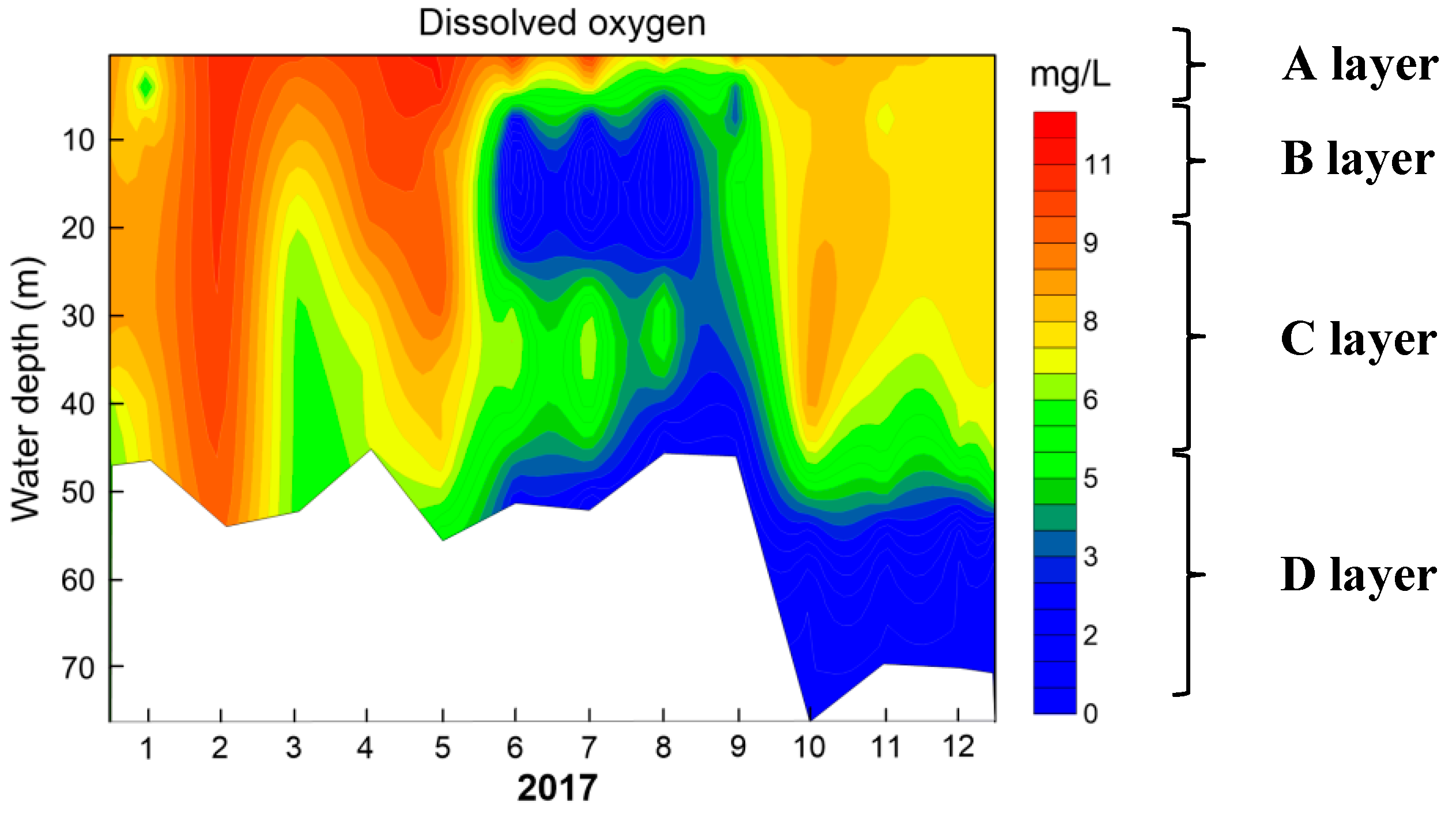
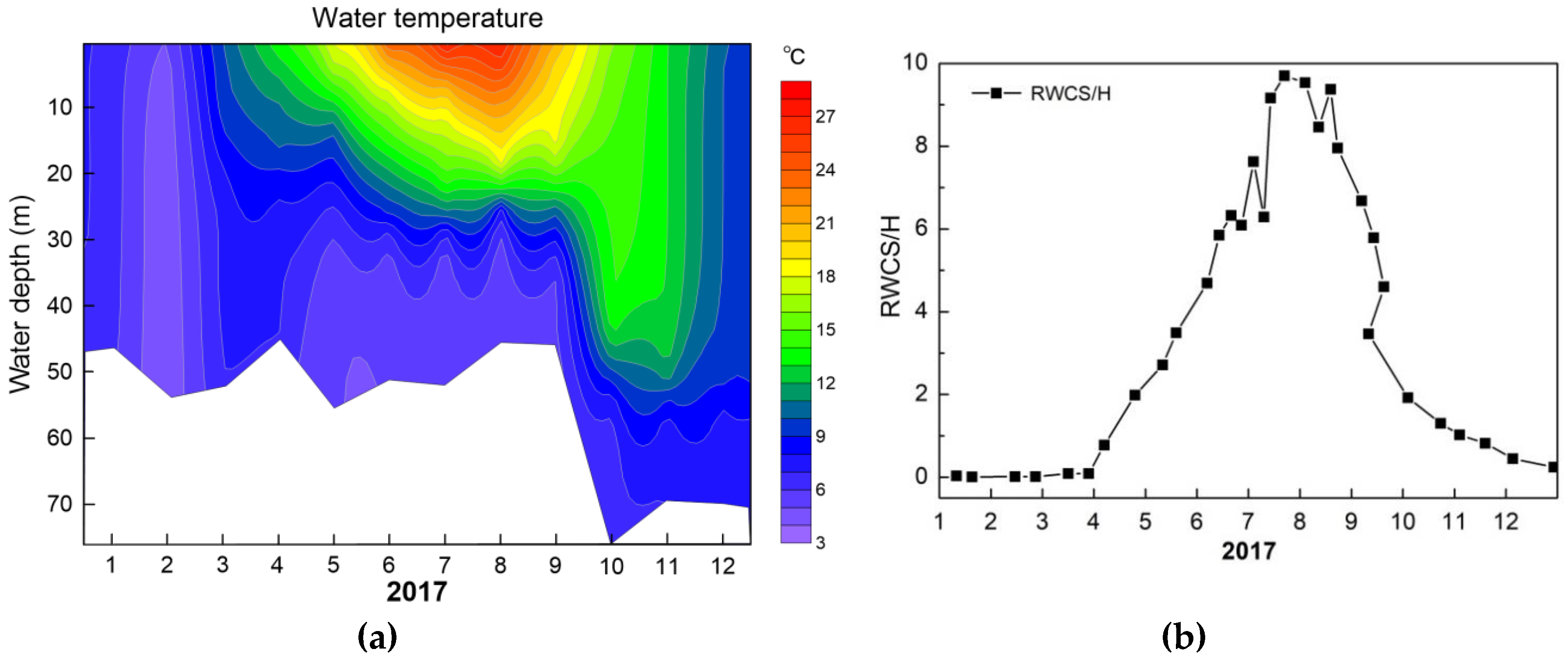
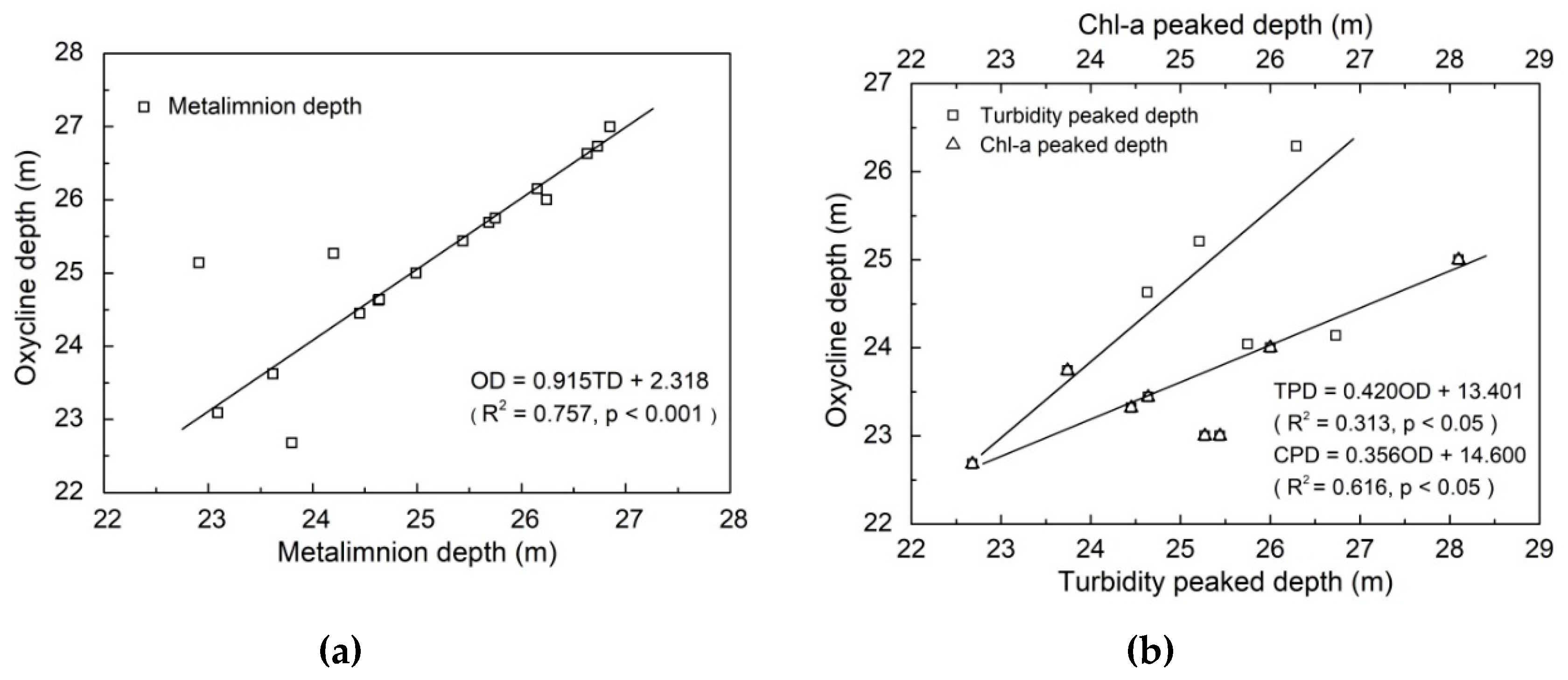
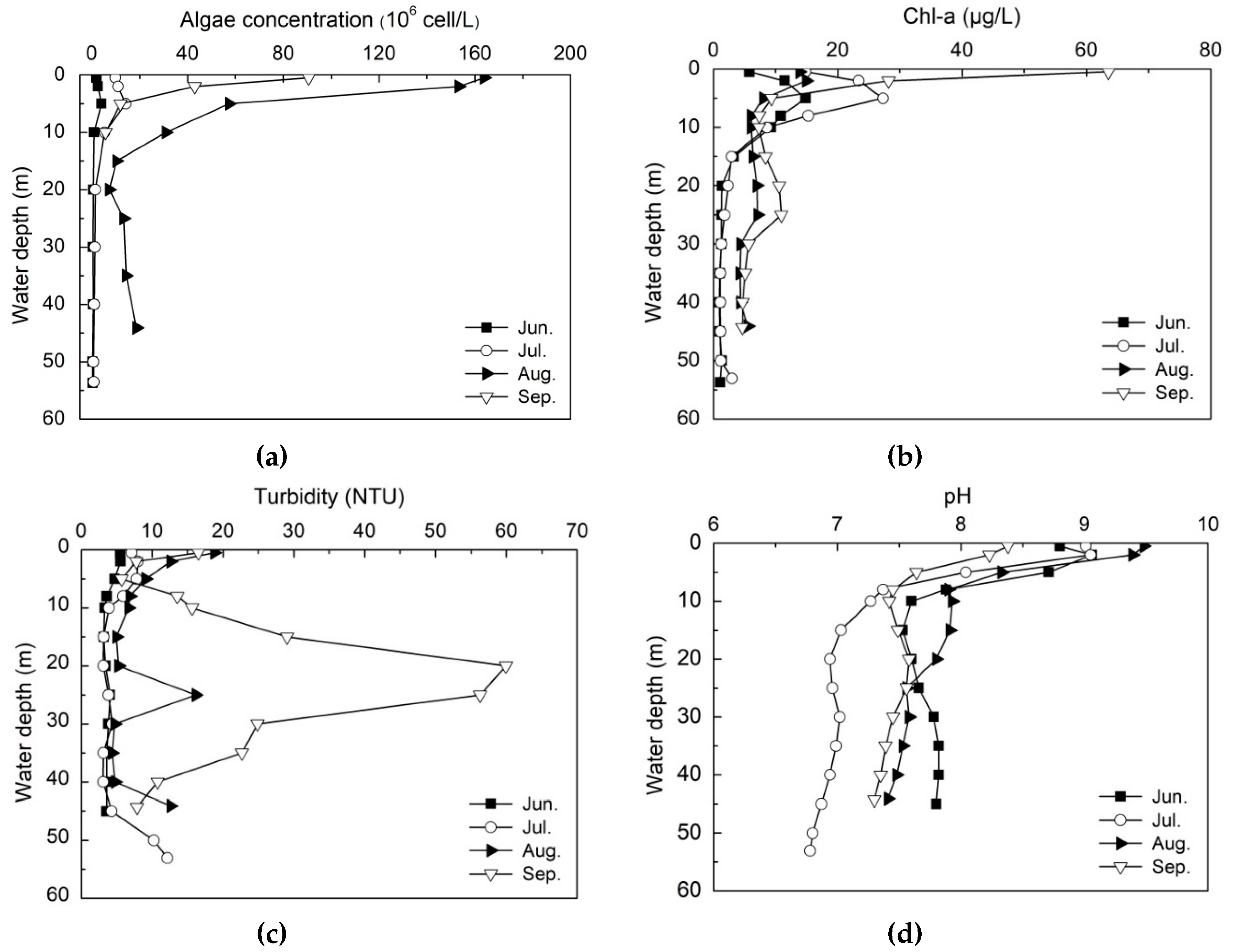
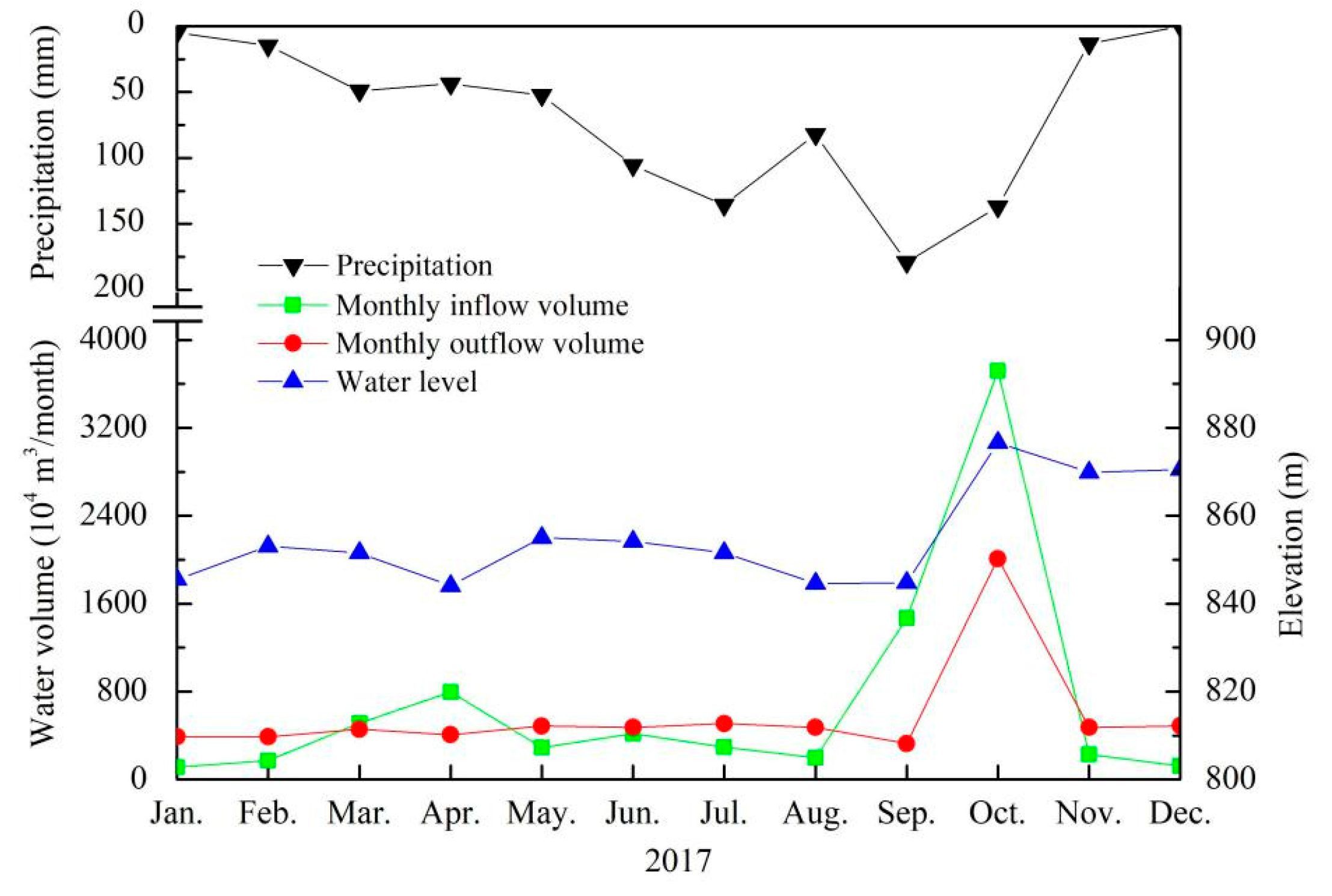
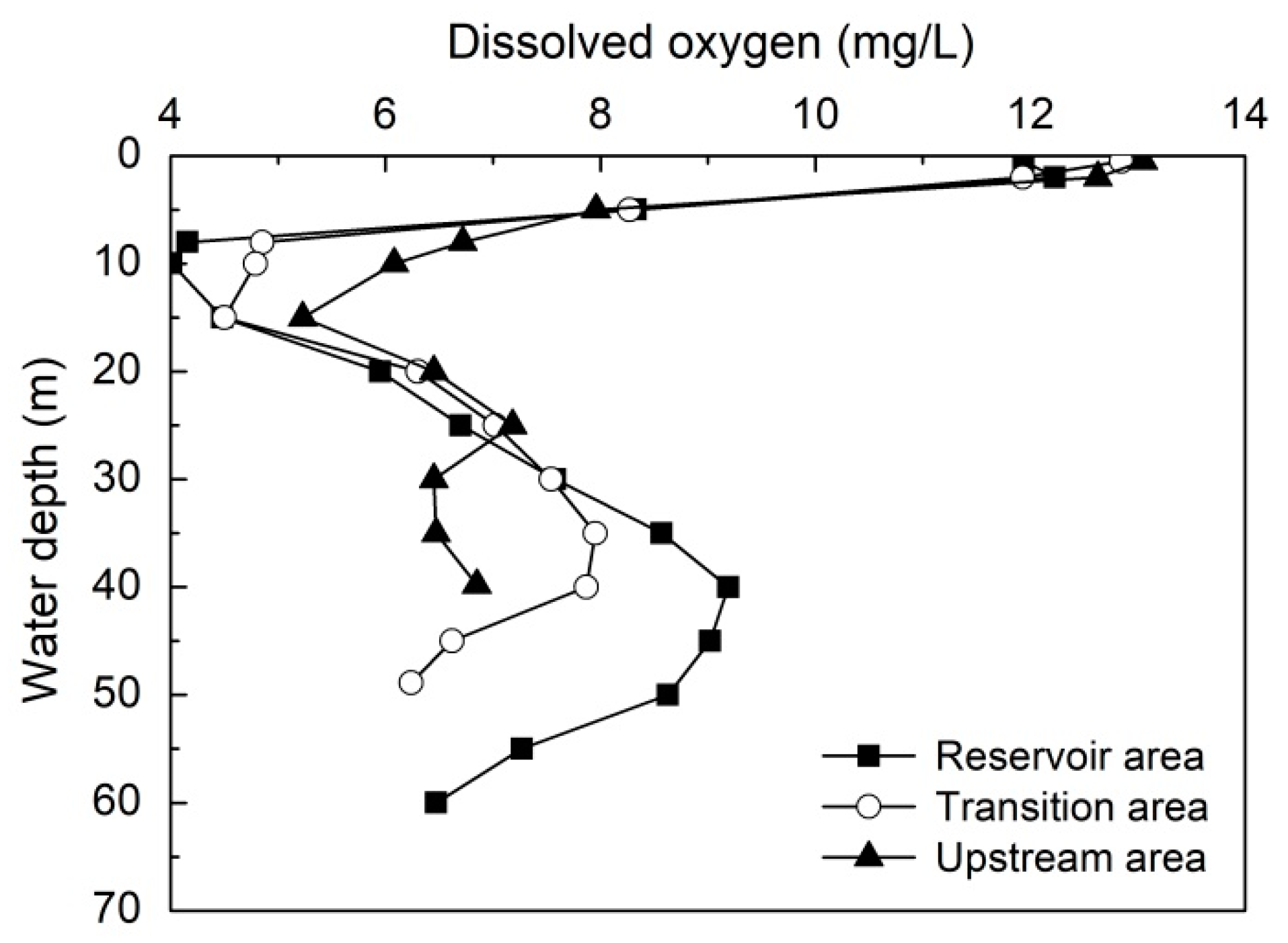
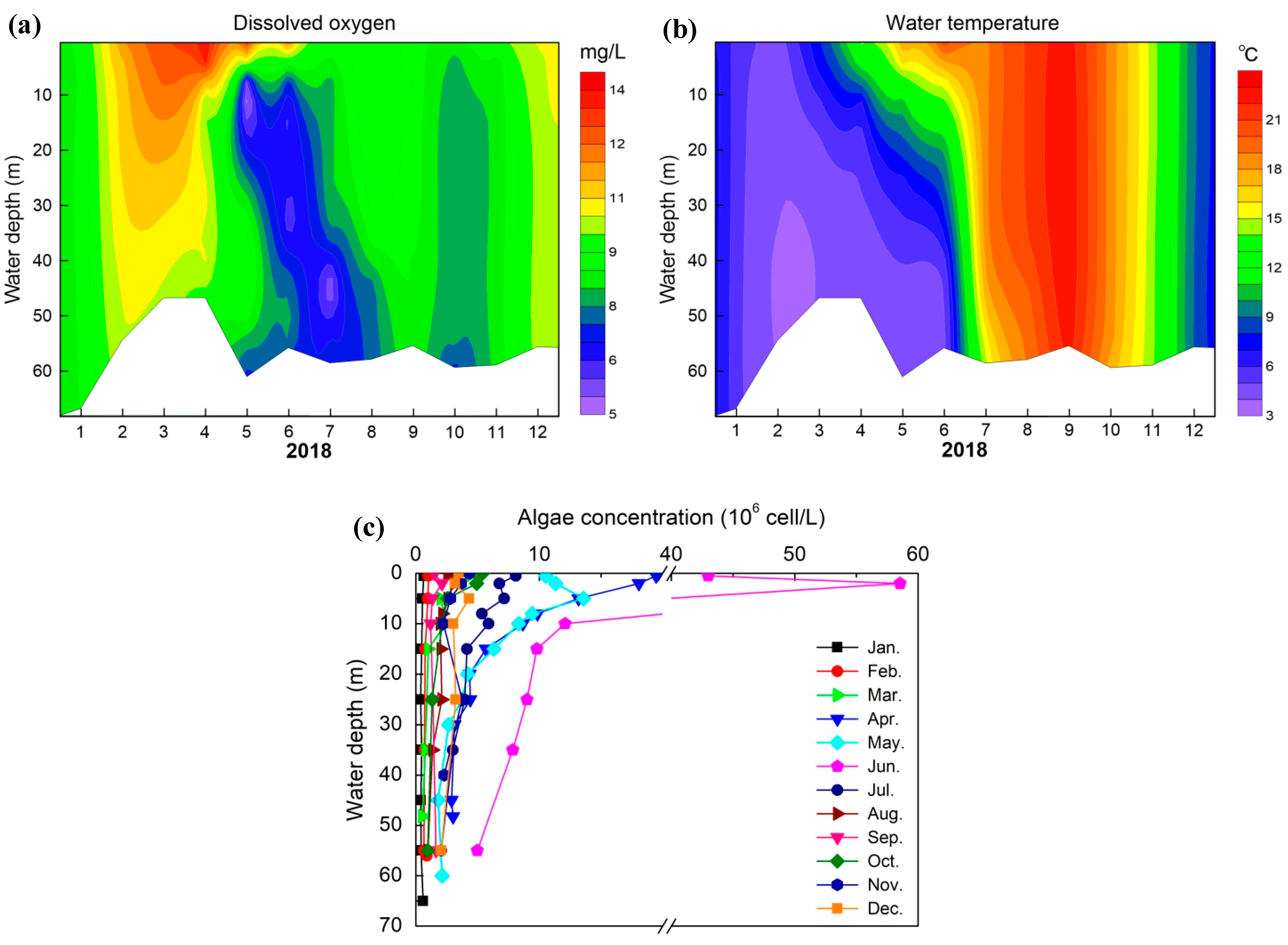
| Month | Total Depth (m) | Anoxia Layer Thickness (m) | Anoxia Layer Proportion (%) |
|---|---|---|---|
| June | 53.7 | 0 | 0 |
| July | 51.1 | 15.7 | 30.7 |
| August | 44.1 | 19.3 | 43.8 |
| September | 44.3 | 3.2 | 7.2 |
© 2019 by the authors. Licensee MDPI, Basel, Switzerland. This article is an open access article distributed under the terms and conditions of the Creative Commons Attribution (CC BY) license (http://creativecommons.org/licenses/by/4.0/).
Share and Cite
Huang, Y.; Yang, C.; Wen, C.; Wen, G. S-type Dissolved Oxygen Distribution along Water Depth in a Canyon-shaped and Algae Blooming Water Source Reservoir: Reasons and Control. Int. J. Environ. Res. Public Health 2019, 16, 987. https://doi.org/10.3390/ijerph16060987
Huang Y, Yang C, Wen C, Wen G. S-type Dissolved Oxygen Distribution along Water Depth in a Canyon-shaped and Algae Blooming Water Source Reservoir: Reasons and Control. International Journal of Environmental Research and Public Health. 2019; 16(6):987. https://doi.org/10.3390/ijerph16060987
Chicago/Turabian StyleHuang, Yuwei, Chun Yang, Chengcheng Wen, and Gang Wen. 2019. "S-type Dissolved Oxygen Distribution along Water Depth in a Canyon-shaped and Algae Blooming Water Source Reservoir: Reasons and Control" International Journal of Environmental Research and Public Health 16, no. 6: 987. https://doi.org/10.3390/ijerph16060987
APA StyleHuang, Y., Yang, C., Wen, C., & Wen, G. (2019). S-type Dissolved Oxygen Distribution along Water Depth in a Canyon-shaped and Algae Blooming Water Source Reservoir: Reasons and Control. International Journal of Environmental Research and Public Health, 16(6), 987. https://doi.org/10.3390/ijerph16060987





